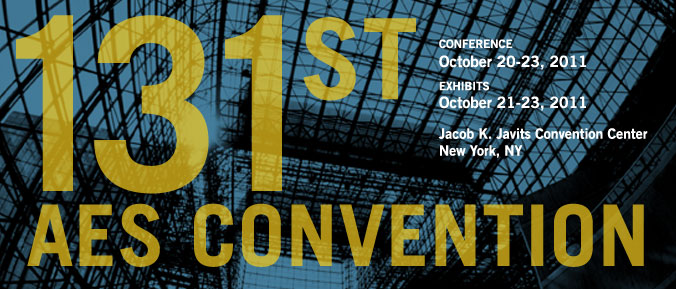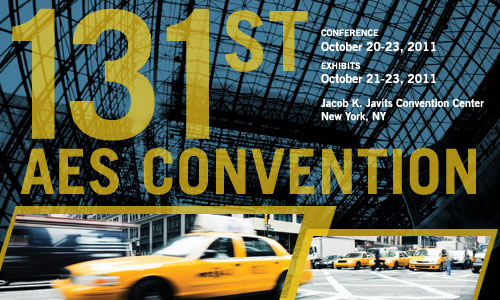
AES New York 2011
Poster Session P19
P19 - Recording and Reproduction
Saturday, October 22, 9:30 am — 11:00 am (Room: 1E Foyer)
P19-1 A Revised Approach to Teaching Audio Mixing Techniques: Applying the Deliberate Practice Model—John Holt Merchant, III, Middle Tennessee State University - Murfreesboro, TN, USA
An overview of the Mixing Techniques course currently offered at Middle Tennessee State University, which was designed to help students develop substantive foundational knowledge and technological competencies regarding the aesthetic and technological aspects of audio mixing techniques by applying the tenets of the Deliberate Practice model. Relevant studies in human performance, characteristics of Millennial students, and pedagogy for developing mental models of audio engineering systems are considered as they apply to recording arts course and curricular design. The results of this study suggest that implementing rigorous, formal practice of foundational skills in audio mixing courses significantly improves students’ capabilities.
Convention Paper 8543 (Purchase now)
P19-2 Sound Field Recording and Reproduction Using Transform Filter Designed in Spatio-Temporal Frequency Domain—Shoichi Koyama, Ken'ichi Furuya, Yusuke Hiwasaki, Yoichi Haneda, NTT Cyber Space Laboratories, NTT Corporation - Tokyo, Japan
A method of transform from the received signals of a microphone array to the driving signals of a loudspeaker array for sound field reproduction is investigated. Our objective is to obtain the driving signal of a planar or linear loudspeaker array only from the sound pressure distribution acquired by a planar or linear microphone array. We derive a formulation of the transform from the received signals of the microphone array to the driving signals of the loudspeaker array. The transform is achieved as the mean of a filter in a spatio-temporal frequency domain. Results of measurement experiments in an anechoic room are presented to compare the proposed method with the method based on the conventional least mean square algorithm. The reproduction accuracies were found to be almost the same, but the filter size and amount of calculation required for the proposed method were much smaller than those for the least mean square algorithm based one.
Convention Paper 8544 (Purchase now)
P19-3 Practical Digital Playback of Gramophone Records Using Flat-Bed Scanner Images—Baozhong Tian, West Virginia University Institute of Technology - Montgomery, WV, USA; Samuel Sambasivam, Azusa Pacific University - Azusa, CA, USA; John L. Barron, The University of Western Ontario - London, Ontario, Canada
We present an Optical Audio Reconstruction (OAR) system to play the audio from gramophone records based on image processing. OAR uses an off-the-shelf scanner to achieve an affordable and practical method of reconstructing audio. Converting the analog records to a digital format is important for preserving many historical recordings. We scan the records using a high resolution large format flat-bed scanner. The images were then segmented and the grooves were tracked to simulate the movement of the stylus. The sound signal was converted from the groove track positions. Our OAR algorithm was able to reconstruct the audio successfully from scanned records. We demonstrated that a fast OAR system producing good quality sound can be built economically.
Convention Paper 8545 (Purchase now)
P19-4 CAIRA—A Creative Artificially-Intuitive and Reasoning Agent as Conductor of Telematic Music Improvisations—Jonas Braasch, Doug Van Nort, Selmer Bringsjord, Pauline Oliveros, Anthony Parks, Colin Kuebler, Rensselear Polytechnic Institute - Troy, NY, USA
This paper reports on the architecture and performance of the Creative Artificially-Intuitive and Reasoning Agent CAIRA as a conductor for improvised avant-garde music. CAIRA listening skills are based on a music recognition system that simulates the human auditory periphery to perform an Auditory Scene Analysis (ASA). Its simulation of cognitive processes includes a comprehensive cognitive calculus for reasoning and decision-making using logic-based reasoning. In a specific application, CAIRA is used as conductor for live music performances with distributed ensembles, where the musicians are connected via the internet. CAIRA uses a visual score and directs the ensemble members based on tension arc estimations for the individual music performers.
Convention Paper 8546 (Purchase now)
P19-5 Discrimination between Phonograph Playback Systems—David M. Weigl, Jason Hockman, Catherine Guastavino, Ichiro Fujinaga, McGill University - Montreal, Quebec, Canada
Digitization of phonograph records is an important step toward the preservation of our cultural history and heritage. The phonograph playback systems (PPS) required for this digitization process are comprised of several components in a variety of price ranges. We report on the results of two listening tests intended to ascertain the extent to which expert listeners can discriminate between PPS of different price ranges. These results are intended to determine the extent to which component selection affects the discrimination between PPS and to provide a set of guidelines for the purchase of PPS components for the digitization of phonograph record collections.
Convention Paper 8547 (Purchase now)
P19-6 Vibration Analysis of Edge and Middle Exciters in Multiactuator Panels—Basilio Pueo, José Vicente Rico, University of Alicante - Alicante, Spain; José Javier López, Technical University of Valencia - Valencia, Spain
Multiactuator panels (MAPs) are an extension of the distribute mode technology in order to be employed for Wave Field Synthesis (WFS) applications. In this paper a special type of semiclamped boundary condition that exhibited proper results in recent convention papers by the authors, is used for setting a MAP ready for use. For that purpose, the surface velocity over specific points has been measured with a Laser Doppler Vibrometer, paying special attention to representative exciter locations: central area, edge, and corners. For an understanding of the sound-generating behavior of the panel, measures were taken both for exciters accommodated in a roughly centered line, as in the rest of MAP prototypes and for an identical array of exciters positioned at the upper side of the panel, in which the behavior was still acceptable for WFS purposes. Experiments were also conducted to analyze the role that the exciter coupling ring, used to physically attach transducer to panel, has on the vibrational behavior and radiated sound.
Convention Paper 8548 (Purchase now)
P19-7 Challenges in 2.4 GHz Wireless Audio Streaming—Robin Hoel, Tomas Motos, Texas Instruments Inc. - Oslo, Norway
Based on the experiences accumulated during the development of a family of 2.4 GHz wireless audio streaming ICs, the paper presents challenges in providing high-quality, uninterrupted audio streaming in the 2.4 GHz ISM band. It discusses the impairments to expect in a dense indoor radio environment, gives an overview of the main interfering radio standards in the 2.4 GHz band that any such system must coexist with, and outlines methods and techniques that are essential in order to overcome these difficulties. To exemplify, some of the critical design choices that were made for the first device in the family are presented along with thoughts on possible future improvements.
Convention Paper 8549 (Purchase now)
P19-8 Ray-Traced Graphical User Interfaces for Audio Effect Plug-ins—Benjamin Doursout, ESIEA—École supérieure d’informatique, électronique, automatique - Laval, France; Jörn Loviscach, Fachhochschule Bielefeld (University of Applied Sciences) - Bielefeld, Germany
On the computer, effects and software-based music synthesizers are often represented using graphical interfaces that mimic analog equipment almost photorealistically. These representations are, however, limited to a fixed perspective and do not include more advanced visual effects such as polished chrome. Leveraging the flexibility of the audio plug-in programming interface, we have created software that equips a broad class of synthesis and effect plug-ins with interactive, ray-traced 3-D replicas of their user interface. These 3-D models are built automatically through an automated analysis of each plug-ins’ standard 2-D interface. Our experiments show that interactive frame rates can be achieved even with low-end graphics cards. The methods presented may also be used for an automatic analysis of settings and for realistic interactive simulations in the design phase of hardware controls.
Convention Paper 8550 (Purchase now)
Information Last Updated: 20111018, saj

